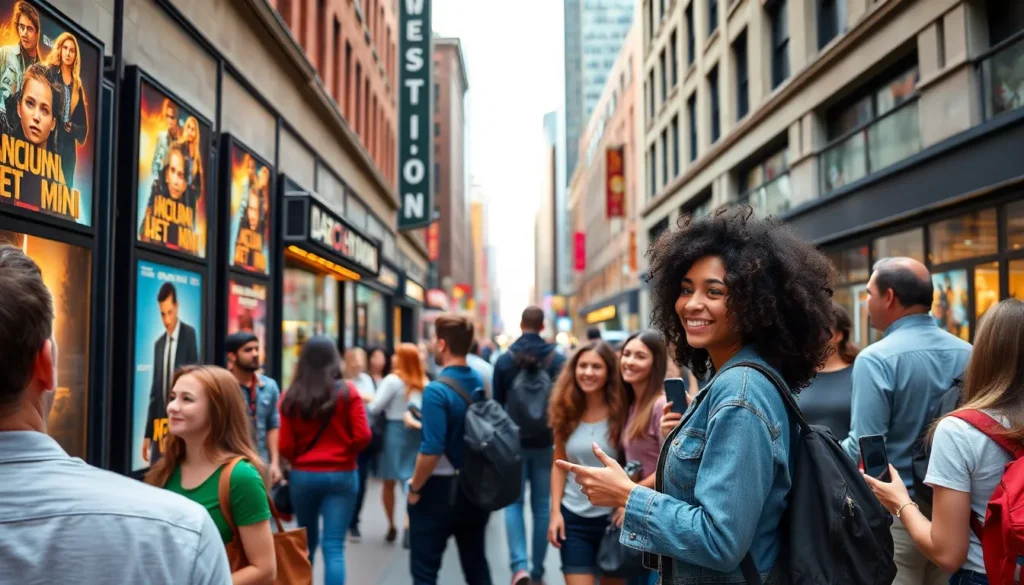Contemporary cinema is like a buffet of flavors, and everyone’s invited. From heart-pounding thrillers to laugh-out-loud comedies, today’s films reflect a world that’s constantly evolving. It’s not just about popcorn and blockbuster hits anymore; it’s a vibrant tapestry of storytelling that captures the complexities of modern life.
Contemporary Cinema
Contemporary cinema encompasses a broad spectrum of genres, from thrillers to comedies, showcasing the diverse preferences of modern audiences. Storytelling has evolved, reflecting societal complexities and embracing themes of identity, culture, and technology. Filmmakers strive to create narratives that resonate with viewers, often drawing on personal experiences and global events.
International cinema plays a significant role in contemporary film, introducing stories and styles from various cultures. The globalization of film distribution enables audiences to access a wider array of international films, enriching their cinematic experience. Streaming platforms contribute to this expansion, offering films that might not have received traditional theatrical releases.
Innovative storytelling techniques emerge in contemporary cinema, such as non-linear narratives and unique visual styles. Filmmakers experiment with new technologies, integrating virtual reality and interactive storytelling into their projects. These advancements challenge conventional filmmaking and captivate new generations of viewers.
Diversity in representation is another hallmark of contemporary cinema. Increased awareness of underrepresented voices leads to more stories that explore various perspectives. Authentic representation fosters greater understanding and acceptance, promoting inclusivity within the film industry.
Changes in audience consumption patterns significantly impact how films are produced and marketed. Viewers seek content that aligns with their values and interests, prompting creators to respond to these expectations. The rise of social media also influences film promotion and audience engagement, enabling fans to connect with their favorite filmmakers and actors directly.
Key Characteristics of Contemporary Cinema

Contemporary cinema boasts several defining traits that reflect its evolution. Themes of identity, culture, and technology permeate modern storytelling.
Diverse Genres and Storytelling
Films today explore a wide range of genres including thrillers, dramas, and comedies. Storytelling employs innovative approaches, often blending elements from various styles. Narratives draw inspiration from both personal experiences and global events, establishing deeper connections with viewers. Movies increasingly challenge traditional formats, incorporating non-linear timelines and experimental structures. Filmmakers prioritize authentic representation, ensuring diverse voices contribute to the narrative landscape. Results include richer, more relatable stories that resonate with a broader audience.
Technological Advancements
Technological innovations shape contemporary cinema in multiple ways. Filmmakers utilize virtual reality, enhancing viewer engagement and immersion. Streaming platforms provide unprecedented access to international films, broadening audience horizons. High-definition cinematography and advanced editing techniques elevate visual storytelling. Filmmaking software offers creators new ways to craft their vision, making production more accessible. Audiences now experience films across various devices, adapting consumption patterns to fit their lifestyles. These advancements cultivate a more interactive relationship between fans and filmmakers, enriching the overall cinematic experience.
Influential Directors and Filmmakers
Contemporary cinema thrives on the creativity and vision of influential directors and filmmakers. These individuals shape narratives and redefine genres, reflecting the multifaceted nature of modern storytelling.
Emerging Voices in Film
Emerging filmmakers are reshaping the cinematic landscape with fresh perspectives. Many bring unique cultural backgrounds that enrich the storytelling. Directors like Ariana DeBose, known for her work in “West Side Story,” and Chloé Zhao, recognized for her Oscar-winning film “Nomadland,” exemplify new voices in the industry. Both prioritize authenticity and representation, focusing on stories that resonate with diverse audiences. Their innovative techniques and bold narratives engage viewers while challenging traditional norms.
Established Icons
Established filmmakers continue to exert significant influence on contemporary cinema. Directors like Martin Scorsese and Quentin Tarantino shape modern storytelling with their distinct styles. Scorsese’s ability to blend historical narratives with personal stories captivates audiences, illustrated through films like “The Irishman.” Tarantino’s signature nonlinear storytelling and sharp dialogue, evident in “Pulp Fiction,” push the boundaries of conventional filmmaking. Both directors remain influential through bold storytelling and a deep understanding of cinematic history, inspiring new generations.
Themes Explored in Contemporary Cinema
Contemporary cinema delves into complex themes that resonate with today’s audience. Social issues and representation stand at the forefront of many films, highlighting the importance of authentic storytelling.
Social Issues and Representation
Modern films often reflect societal challenges, focusing on themes of race, gender, and class. Filmmakers aim to showcase diverse voices, ensuring that underrepresented communities appear on screen. Productions like “Moonlight” and “The Farewell” have gained acclaim for their authentic portrayals, fostering discussions about identity and belonging. Cinematic storytelling empowers viewers to engage with these relevant issues, bridging gaps in understanding. By prioritizing representation, filmmakers enrich narratives and welcome a broader audience.
The Impact of Globalization
Globalization profoundly influences contemporary cinema, expanding the boundaries of storytelling. Streaming platforms make international films accessible to a worldwide audience, inviting viewers to explore different cultures. This accessibility encourages collaboration among filmmakers across countries, resulting in innovative projects that blend styles and themes. Productions such as “Parasite” exemplify how cross-cultural narratives capture universal experiences while offering distinct cultural insights. By embracing globalization, contemporary cinema creates a rich tapestry of stories that reflects a diverse and interconnected world.
Future of Contemporary Cinema
Emerging trends will significantly shape the future landscape of contemporary cinema. Filmmakers increasingly leverage technology to enhance storytelling. For example, artificial intelligence is becoming a tool for script development, predicting audience preferences, and streamlining post-production processes. This technological integration can create more personalized viewing experiences for audiences.
Diversity and representation remain at the forefront, with filmmakers striving for authenticity across narratives. Voices from marginalized communities will continue to garner attention, driving innovative storytelling that reflects various perspectives. Productions focusing on this inclusivity have the potential to resonate with wider audiences.
Streaming services are set to redefine distribution models further, making it easier for independent films to reach global markets. The accessibility of diverse content will likely influence viewing habits, encouraging audiences to explore international cinema more actively. Encouragingly, this shift could lead to collaborations that merge different cultural storytelling techniques.
Social media’s role in promoting films cannot be overstated. It strengthens connections between filmmakers and audiences while facilitating immediate feedback and discussions. Engaging content across platforms will become crucial for successful marketing strategies.
Audience engagement and interactivity will experience a transformation as virtual and augmented reality gain traction in the cinematic experience. Interactive storytelling invites viewers to participate in narratives, fostering deeper connections with characters and themes.
Ultimately, the landscape of contemporary cinema will continue evolving, shaped by technological advancements, diverse voices, and changing audience expectations. Collaboration among filmmakers, studios, and audiences will create a dynamic environment, ensuring that contemporary cinema remains relevant and impactful.
Conclusion
Contemporary cinema stands as a vibrant reflection of society’s complexities and evolving narratives. With its innovative storytelling techniques and commitment to authentic representation, it captivates audiences worldwide. The influence of technology and globalization enriches the cinematic experience, allowing diverse voices to emerge and thrive.
As filmmakers embrace new tools and platforms, the future promises even more engaging and inclusive stories. The ongoing dialogue between creators and audiences will shape the cinematic landscape, ensuring that contemporary cinema remains a powerful medium for connection and understanding in an ever-changing world.



